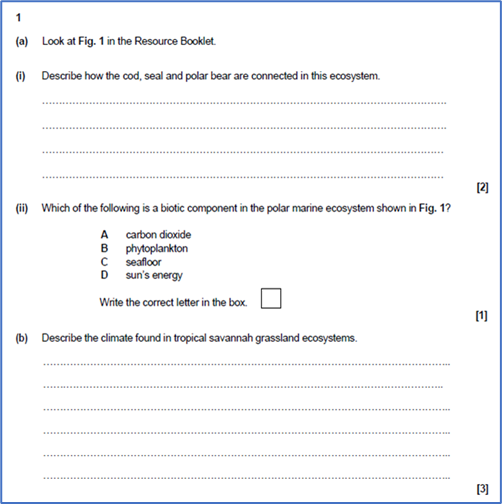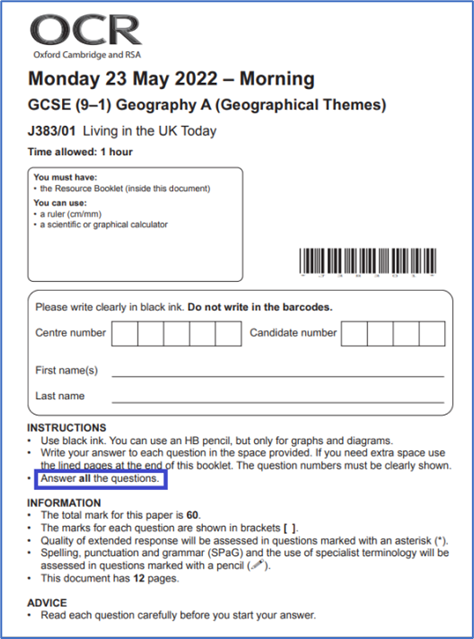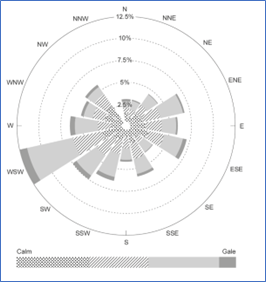Accessibility in geography exams
12 March 2024
Kerry Sage, Geography Subject Advisor

At OCR, we are committed to making exams fair to all our students. In this blog I’ll explain why accessibility is important, and what we’ve been doing to improve accessibility in geography exams.
Why is accessibility important?
Accessibility is important in making exams fair for all students. We are aware that students process information in different ways. Too many words in exam questions and text bunched together increases the cognitive load for students, impairing their ability to answer the question being asked, that ultimately could affect their performance.
We are working on improving the layout of exam questions and simplifying the language used in our geography exams. By doing this is makes it easier for students to understand what the exam question is asking them to do, creating a more robust and valid assessment, testing students on their knowledge, skills, and understanding, as it should be.
What are we doing to make geography exams more accessible?
Over the past few years, we have made changes to our papers and will continue to do so for our 2024 geography question papers. The specific changes are described below.
Aligning all questions
Aligning all questions and sub-questions to the left-hand margin, directly under the question number.
This alignment will:
- create more space on the page for diagrams, charts, graphs, images, and other visuals
- create more space for students to answer questions as they will have the full width of the page
- make it easier for students to follow the text as it all starts from the same vertical point.
How the change looks in the question papers:

Additional answer space
The Additional Answer Space wording has been amended to say Extra Answer Space.
How the change looks in the question papers:
EXTRA ANSWER SPACE
If you need extra space use these lined pages. You must write the question numbers clearly in the margin.
Superfluous text
We are removing superfluous text. For example. “Look at Fig. 5 in the Resource Booklet showing an artist’s impression of global warming”.
This will be replaced with “Look at Fig. 5 in the Resource Booklet”.
How the change looks in the question papers:
Look at Fig. 5 in the Resource Booklet.
(b) Using evidence from Fig. 5, explain how human activity creates the enhanced greenhouse effect.
Front page of the exam paper
Answer all the questions will only appear on the front-page rubric.
It will not be repeated on each section.
How the change looks in the question papers:

The use of bold
The use of bold will be used sparingly to emphasise words or short phrases in questions and instructions/rubrics. For example, the number of points required in the answer, e.g. Give one reason, Suggest two problems with the students’ first question.
How the change looks in the question papers:
(a)
(i) Suggest two problems with the students’ first question.
1 …………………………………………………………………………………
…………………………………………………………………………………
2 …………………………………………………………………………………
…………………………………………………………………………………
[2]
Visual images
Where appropriate diagrams, charts, graphs, images and other visuals will be in grey scale.
How the change looks in the question papers:

Resource booklets
Resource booklets will also be amended from:
“Fig.1 The world map”
to:
“Fig. 1
The world map”
How the change looks in the question papers:
Fig. 1
A landscape at Carding Mill, Shropshire
Multiple choice questions
Where appropriate Multiple Choice Questions (MCQs) will all have the stem “What is……”
How the change looks in the question papers:
(ii) What is the median sediment size on the dispersion graph?
A 2cm
B 11cm
C 25cm
D 31cm
Write the correct letter in the box.  [1]
[1]
Summary
To reflect this change to the question papers, we’ve amended our samples, for example:
You can view all the examples in the Assessment > Sample assessment materials section of the GCSE Geography qualification pages on our website.
See also our subject update and our recent general blog on the importance of accessibility.
We hope this has given you an insight into what accessibility means for exams and shown you some examples of how we are making geography exams more accessible for all students.
We will continue to update and improve our accessibility criteria for all exams, and we are committed to helping students have a fair chance at demonstrating their knowledge and skills.
If you are interested in some further reading on this area, Ofqual published a guidance document based on a 12 week consultation that took place early in 2022.
Stay connected
If you have any questions, you can email us at geography@ocr.org.uk , call us on 01223 553998 or message us on X (formerly Twitter) @OCR_Geography. You can also sign up for email updates for information about resources and support.
About the author
Kerry joined the Subject Advisor team in April 2023 after 18 years of teaching Geography along with other subjects such as Environmental Science. As well as being Head of Geography she had other roles such as associate SLT and Deputy Designated Safeguarding Lead. She loves to travel and trained as an Icelandic Teacher Tour Guide.
Related blog